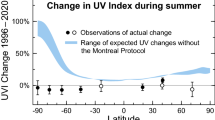Abstract
UV radiation is calculated for Russian regions where anomalies of the total ozone content were observed in the first quarter of 2016. Winter ozone depletion in northern regions of Siberia, even to the levels of the so-called ozone hole, is not critical. However, much weaker ozone reduction in the early spring can lead to dangerous levels of erythemal UV radiation, when skin protection from ultraviolet radiation is required.


Similar content being viewed by others
REFERENCES
Future ozone and its impact on surface UV. Scientific Assessment of Ozone Depletion: 2010. Report N 52, Ed. by S. Bekki, G.E. Bodeker, A.F. Bais, N. Butchart, V.P. Braesicke, A.J. Charlton-Perez, N.E. Chubarova, I. Cionni, L.N.P.S.S.B. Diaz Gillett Pawson, M.A. Giorgetta, D.W. Fahey Eyring, D.E. Kinnison, U. Langematz, B. Mayer, R.W. Portmann, and E. Rozanov (WMO, Geneva, 2011).
A. M. Zvyagintsev, N. S. Ivanova, M. P. Nikiforova, I. N. Kuznetsova, and P. N. Vargin, “Ozone content over the Russian Federation in the first quarter of 2016,” Rus. Meteorol. Hydrol. 41 (5), 373–378 (2016).
M. P. Nikiforova, A. M. Zvyagintsev, P. N. Vargin, N. S. Ivanova, A. N. Lukyanov, and I. N. Kuznetsova, “Anomalously low total ozone levels over the Northern Urals and Siberia in late January 2016,” Atmos. Ocean. Opt. 30 (3), 255–263 (2017).
L. F. Millan and G. L. Manney, “An assessment of ozone mini-holes representation in reanalyses over the Northern hemisphere,” Atmos. Chem. Phys. 17, 9277–9289 (2017).
D. Griffin, K. A. Walker, I. Wohltmann, S. S. Dhomse, M. Rex, M. P. Chipperfield, W. Feng, G. L. Manney, J. Liu, and D. Tarasick, “Stratospheric ozone loss in the Arctic winters between 2005 and 2013 derived with ACE-FTS measurements,” Atmos. Chem. Phys. Discuss (2018).
G. A. Ivlev, B. D. Belan, and V. M. Dorokhov, “Dynamics of solar UV-B and UV-A radiations in Tomsk during ozone anomaly in spring, 2011,” Opt. Atmos. Okeana 26 (11), 995–1004 (2013).
B. M. Knudsen, H. Jonch-Sorensen, P. Eriksen, B. J. Johnsen, and G. E. Bodeke, “UV radiation below an Arctic vortex with severe ozone depletion,” Atmos. Chem. Phys. 5 (2005).
C. Stick, K. Kruger, N. H. Schade, H. Sandmann, and A. Macke, “Episode of unusual high solar ultraviolet radiation over Central Europe due to dynamical reduced total ozone in May 2005,” Atmos. Chem. Phys. 6, 1771–1776 (2006).
G. Bernhard, A. Dahlback, V. Fioletov, A. Heikkila, B. Johnsen, T. Koskela, K. Lakkala, and T. M. Svendby, “High levels of ultraviolet radiation observed by ground-based instruments below the 2011 Arctic ozone hole,” Atmos. Chem. Phys. 13, 10 573–10 590 (2013).
G. L. Manney and Z. D. Lawrence, “The major stratospheric final warming in 2016: Dispersal of vortex air and termination of arctic chemical ozone loss,” Atmos. Chem. Phys. 16, 15 371–15 396 (2016).
F. Khosrawi, O. Kirner, B.-M. Sinnhuber, S. Johansson, M. Hopfner, M. L. Santee, F. Froidevaux, J. Ungermann, R. Ruhnke, W. Woiwode, H. Oelhaf, and P. Braesicke, “Denitrification, dehydration and ozone loss during the 2015/2016 Arctic winter,” Atmos. Chem. Phys. 17, 12 893–12 910 (2017).
Yu. M. Timofeyev, S. P. Smyshlyaev, Y. A. Virolainen, A. S. Garkusha, A. V. Polyakov, M. A. Motsakov, and O. Kirner, “Case study of ozone anomalies over Northern Russia in the 2015/2016 winter: Measurements and numerical modeling,” Ann. Geophys. 36, 1495–1505 (2018).
K. Vanicek, T. Frei, Z. Litynska, and A. Schmalwieser, UV-Index for the Public (European Communities, Brussels, 2000).
N. Chubarova and Ye. Zhdanova, “Ultraviolet resources over Northern Eurasia,” Photochem. Photobiol. 127, 38–51 (2013).
T. B. Fitzpatrik, “The validity and practicality of sunreactive skin types i through vi,” Arch. Dermatol. 124, 869–871 (1988).
Rationalizing nomenclature for UV doses and effects on humans. WMO/GAW Report No. 211 (Vienna, Commission Internationale de l’Eclairage (CIE), 2006).
ACKNOWLEDGMENTS
This work was financially supported by the Russian Science Foundation (grant no. 14-17-00096).
Author information
Authors and Affiliations
Corresponding author
Additional information
Translated by S. Ponomareva
Rights and permissions
About this article
Cite this article
Chubarova, N.E., Timofeev, Y.M., Virolainen, Y.A. et al. Estimates of UV Indices During the Periods of Reduced Ozone Content over Siberia in Winter–Spring 2016. Atmos Ocean Opt 32, 177–179 (2019). https://doi.org/10.1134/S1024856019020040
Received:
Revised:
Accepted:
Published:
Issue Date:
DOI: https://doi.org/10.1134/S1024856019020040




